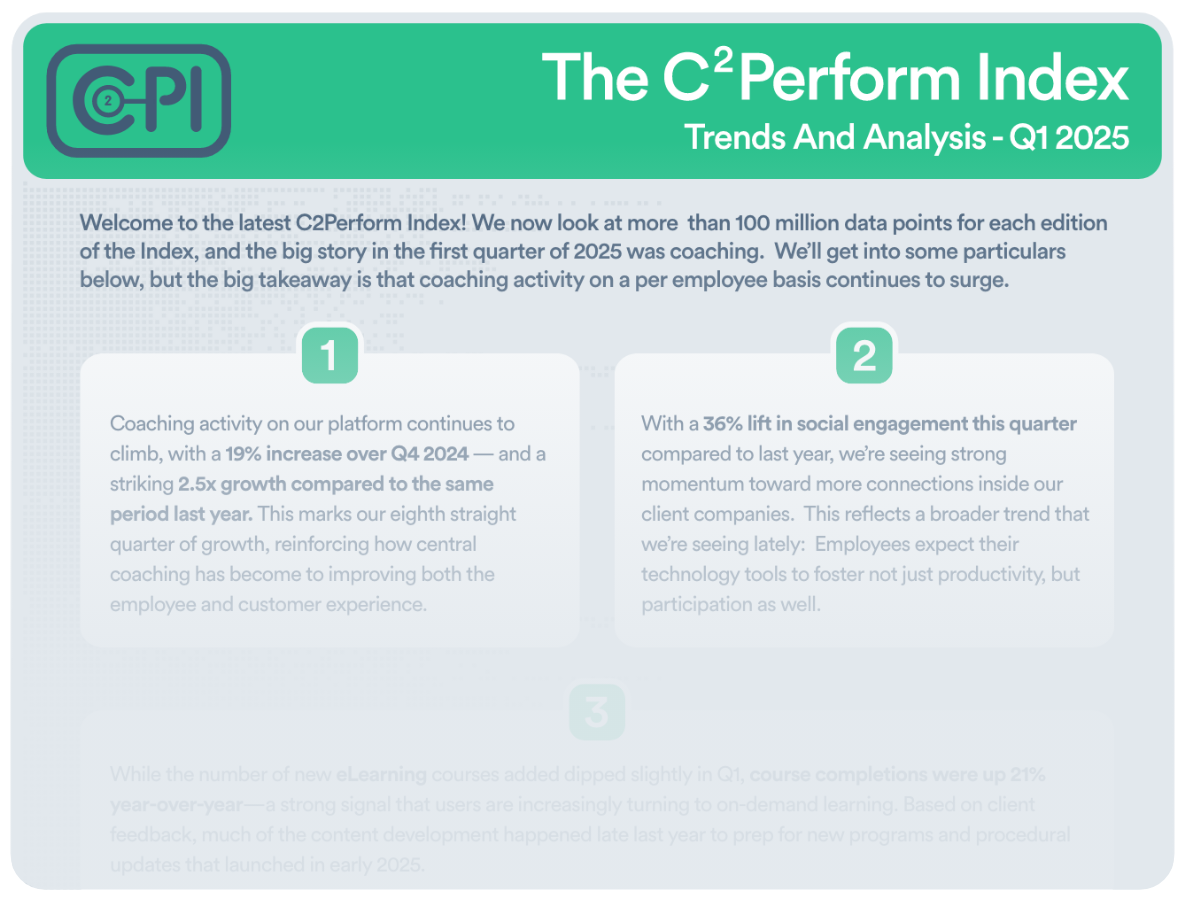Customer support operations - whether they are contact centers, finance and accounting operations or insurance claims management - are evolving rapidly... and it’s not just a tech challenge anymore. Leaders are navigating different work environments, rising expectations around coaching and training, and growing demands for seamless, scalable customer experiences. (Not to mention trying to become AI experts overnight.)
It’s a tough balancing act.
That’s why we created the C2Perform Index (C2PI)—a quarterly look at real behaviors, trends, and patterns in support organizations around the globe. For over five years, we’ve analyzed data from millions of frontline interactions across 30+ countries to uncover trends that are shaping customer service and support operations—trends that often fly under the radar, but often tell a powerful story.
Here’s what we learned in Q1 2025—and what it means for your team.
The Common Pain Points Aren't Going Away
Across industries, the challenges are familiar—and stubbornly persistent. In the data and our conversations with support leaders, a few themes kept coming up:
-
Coaching can feel like a checkbox, not a culture
-
Knowledge stays stuck in silos that lead to repeated mistakes and wasted time
-
Employee recognition is too rare (or too vague)
-
Training continues to evolve but doesn't always land
-
Leaders lack visibility into what's actually working (and what's not)
These aren’t just operational headaches—they affect team morale, customer experience, and overall performance.
And while many teams know something isn’t working, they’re often unsure where to start. That’s where the data comes in.
What the Data Tells Us: Emerging Shifts in Behavior
We dug into more than 100 million data points to produce the Q1 2025 C2PI. The picture that emerged shows clear momentum in some areas—and some fascinating early trends in others.
1. Coaching frequency went up, and it's working.
Compared to the time last year, we saw a 153% increase in coaching sessions per employee. That’s a big shift. At the same time, Performance Improvement Plans (PIPs) dropped by 20.5%.
What does this mean?
It suggests that when teams prioritize regular, consistent coaching, fewer issues escalate to the point of needing formal intervention. It’s a strong signal that organizations are starting to catch and correct performance gaps earlier—through conversations, not consequences.
2. Learning continues to blend.
There was a 21% increase in eLearning course completions, but interestingly, instructor-led sessions also rose by 14%.
This dual rise shows that teams aren’t abandoning live training—they're complementing it. Now that most companies have settled into their preferred work environments (remote, hybrid, or in-person), learning delivery is becoming more intentional and balanced.
The takeaway: support leaders are investing in flexibility and accessibility—while still creating space for deeper, human-centered learning moments.
3. Knowledge Management practices may be maturing - but still have a long way to go.
We saw a 34% increase in knowledge base content being published this quarter. That’s a positive sign: teams are building better self-service tools and codifying their expertise.
At the same time, knowledge base visits dipped slightly.
That might sound concerning, but we think it may actually point to something good: better information retention and improved training, which is a key indicator of a healthy, maturing knowledge management process. If employees are finding answers the first time, or absorbing the knowledge during onboarding or coaching, they don’t need to go searching as often.
Of course, this is one to keep an eye on. It could also signal a drop in trust in KB content—or a UX issue—but so far, paired with other trends, the data leans positive.
From Insights to Action
We all know it’s one thing to know what’s happening. It’s another to do something with it.
If your team is struggling with visibility or unsure where to focus, hopefully this edition of the Index will give you some ideas. Here are three ways you might act on this quarter’s insights:
-
Reevaluate your coaching cadence. Are you coaching often enough to create momentum, not just fix problems? If not, start small—aim for frequent, short sessions that build habits over time.
-
Audit your learning library. Does your training content reflect your current workflows and realities? Are you balancing digital self-paced options with opportunities for live connection? Do you have a consistent approach to learning reinforcement?
-
Dig into your knowledge base analytics. Look for top-performing articles, gaps, and trends in search queries. Use that data to refine your content or improve visibility during onboarding.
These shifts won’t happen overnight—but the most effective support orgs are building them into their culture, one step at a time.
The Index is just the Beginning
Every quarter, the C2PI surfaces the trends that matter most in frontline performance, coaching, training, and employee engagement. We don’t just publish charts—we connect the dots and share what those numbers mean in the real (your) world. Plus, you can get through it in a few minutes.
Whether you’re leading a team of 20 or 2,000, these insights can help you make better decisions, faster.
Bringing Insights to Life
Whether you're scaling a growing team, tackling disengagement, or simply looking to sharpen your operations, having the right tools—and the right insights—makes all the difference. At C²Perform, we’ve spent over a decade helping support organizations turn performance data into meaningful action. Built by practitioners, trusted by teams in 30+ countries, and designed with real-world simplicity in mind, our platform is shaped by the same trends we track. If you're curious what that looks like in practice, the C2PI is a great place to start. And if you’d like to explore how these insights could apply to your team, you’re always welcome to schedule a quick discovery call with one of our performance advisors.
 English
English Español
Español









